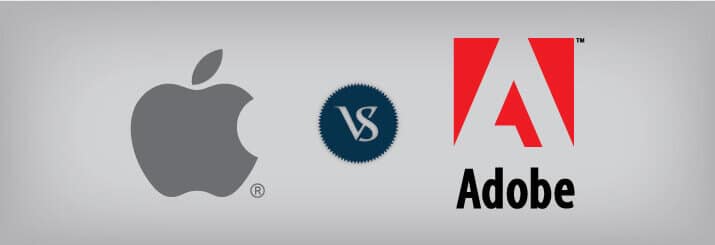I remember Flash. Believe it or not, Flash was supposed to be just a vector-based web animation program. It was a new way for animators to make animations on the web. It’s roots come from a small software company called FutureWave Software. They had a vector-based drawing program for pen-based computers called SmartSketch and once the idea of animation was added, FutureSplash Animator was born. In 1996, Macromedia bought FutureWave and re-released FutureSplash Animator as Macromedia Flash. Then in 2005, Adobe (Macromedia’s long-time rival in graphic/web/multimedia design software) acquired Macromedia.
Over the years Flash has made enormous advancements and every new version came with new features and technology. With these new tools, web designers used Flash to create certain website elements such as menu bars, banners, photo galleries and even the whole website itself. As a designer back then, it was a lot easier to make a menu bar in Flash compared to making it in Javascript because you didn’t have to know Javascript. Shoot, you didn’t even need Photoshop to do it because of Flash’s built in design tools.
Hollywood-style opening intros for websites were the rage, animators were able to create super-slick short films and Flash was the perfect marriage for audio and video on the Internet. You can create a mp3 player and/or a video player very easily with Flash. A very large amount of video that’s watched on the Internet is played with a Flash Player. Flash was such a large presence on the Internet that web browsers came with it pre-installed.
Then in 2007, Apple released the much anticipated iPhone. Adobe’s Flash plug-in (along with Java applets) were unsupported. People were stunned. “What? No Flash!!? That’s just crazy. What kind of Internet experience can you have without Flash?” Adobe said Flash for the iPhone was on the way and Apple said once it was ready, they would allow the iPhone to support it.
Three years later there’s STILL no Flash for the iPhone. Apple, earlier this year also released the iPad (a touchscreen tablet) without Flash support. So why isn’t Flash available for the iOS (the operating system that runs on the iPhone and iPad)? Who’s to blame, Apple or Adobe?
Shortly after the iPad’s release, Apple’s CEO Steve Jobs wrote an essay – Thoughts on Flash. Adobe’s CEO, Shantanu Narayen gave his response in an interview with The Wall Street Journal.
Believe who you want but ever since then, there’s been a heated debate – Flash vs. HTML5.
For web designer and developers this is pretty big news. HTML5 has many great features but the fact that it’s still currently under development and won’t be a standard for quite some time isn’t helping its cause. You can currently use HTML5 but all web browsers don’t support the same HTML5 features. For example, Apple’s web browser Safari supports HTML5 but you have to use Safari. Use Firefox and go to http://www.apple.com/html5/ . You will be prompted to download and use Safari. The big deal with this debate is geared mostly towards online video. iPhone and iPad users (which are growing in huge numbers) can’t watch video in Flash, only HTML5.
HTML5 is very, very promising but it still has a ways to go. As a web developer I’m happy to see Apple pushing HTML5, CSS and Javascript instead of Flash. I feel it’s just going to make me a better developer in the long run. Honestly, while I feel Flash has been a great asset to multimedia and the Internet, I didn’t realize it made me a lazy web developer. Doing things in Flash was often easier and faster and it required hardly any coding for most things. Over the past couple years, I haven’t used Flash in any of the websites I’ve developed for anything other than video. And that looks like it might be changing also.
In my opinion as a designer/developer who’s used both Adobe’s and Apple’s products for the past 14 years, it is Adobe who is at fault for Flash’s downward spiral. It comes down to Adobe having a hard time getting Flash to work optimally on mobile devices, including notebooks.
Recently Apple released a new version of the MacBook Air. It was the first Mac that Apple shipped in the last decade without Flash preinstalled. Apple’s response was that its just better and more secure for users if they download and install the latest version of the Flash plug-in instead of having an older, possibly less secure version of Flash installed. Makes sense.
Then Ars Technica reviewed one of the new MacBook Airs and discovered that having Flash installed cut battery runtime up to 33%. That’s a pretty dramatic decrease in battery time on a notebook, imagine that on your smartphone. Maybe Steve Jobs was right.
If you search the web, you’ll find numerous debates arguing for Flash and against it. Arguments for HTML5 and reasons against it. It’s all of matter of preference and who you are going to develop for.
I think Adobe will fix Flash eventually and you’ll be seeing Flash on an iPhone and iPad. Technology changes and gets better everyday and that will only help Adobe fix it. While HTML5 gets more popular, Flash will still be around. I don’t see Flash dying for a long time. Not until HTML5 becomes a standard and that might not be until 2022.



